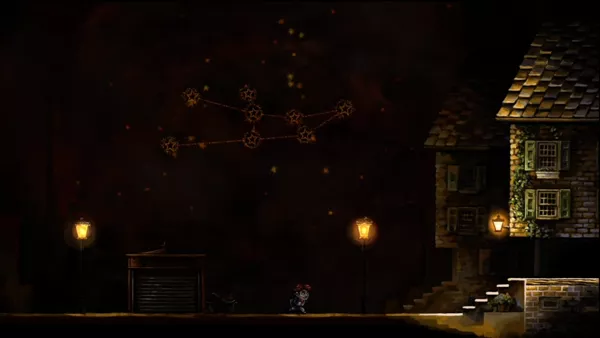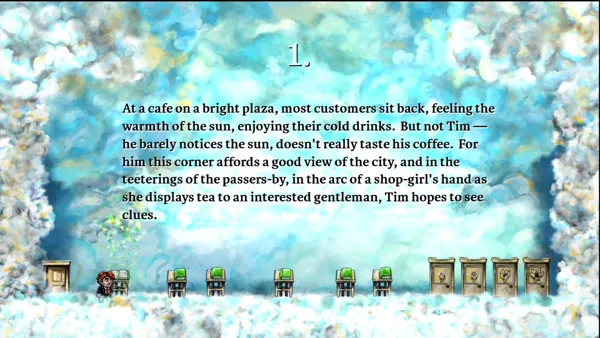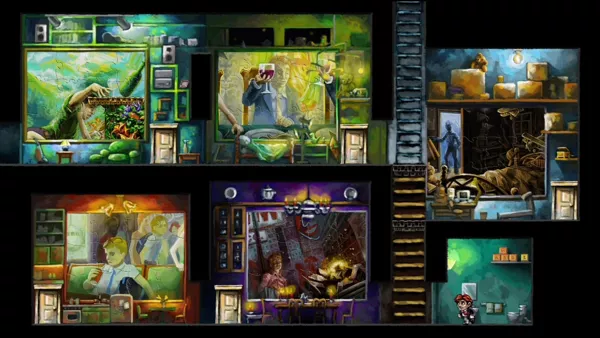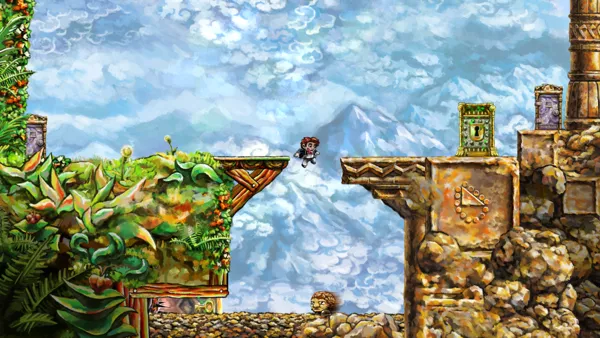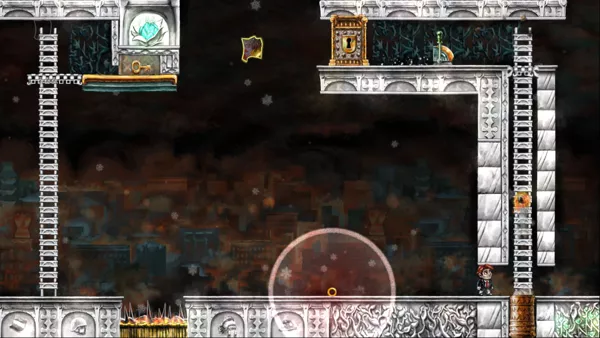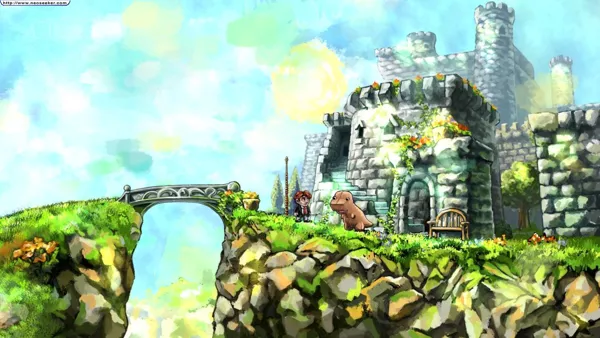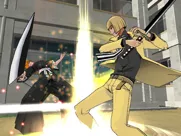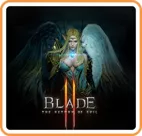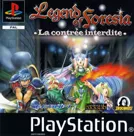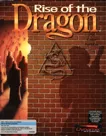Braid
Description official descriptions
Braid is a puzzle game disguised as a 2D platformer. The player controls Tim during his search for a princess he has known and lost. Although the objective appears to be rather straightforward at first, the meaning and the motives become much more implicit and are interwoven with the mechanics during the course of the game. From the main hub, Tim can eventually access six worlds that consist of different areas. The start of each world reveals a part of Tim's background and emotions, rather than progressing a storyline. The second to the sixth world can be entirely explored without solving all the puzzles. Difficult situations can be ignored and revisited later. When all worlds have been completed, the first one becomes available and brings closure to the story.
The game's concept is entirely based on time manipulation. Tim cannot die permanently as the player can rewind time at any moment and usually for any length, even all the way back when an area was entered. While rewinding, the music is synchronized in a similar fashion. Rather than a gimmick, rewinding is an essential element to solve the puzzles. The different worlds give a spin to the mechanic by introducing clones as the player collaborates in a parallel reality with a past version of himself, time can be affected through the movement direction, and Tim can create a circular area to cause time dilation. Certain items, enemies, and parts of the scenery are immune to time manipulation or behave in a very different way. Puzzles require close examination of the environment and the behavior of different items and enemies. As such, the game is entirely about solving the puzzle theoretically by applying the game mechanics and then using trial and error to executive it and discover possible flaws in the proposed logic. This also brings limited replayability to the game.
A world is solved by collecting the puzzle pieces. These need to be arranged and eventually show a picture related to the game's story. There is no filler in the level design, meaning that every platform, item, or game element (except for a few enemies) has a specific purpose to solve a puzzle. Fast times can be tracked in a separate speedrun mode.
The later released Windows and Macintosh versions are identical but come with a level editor.
Spellings
- ブレイド - Japanese spelling
Groups +
Screenshots
Promos
Videos
Add Trailer or Gameplay Video +1 point
See any errors or missing info for this game?
You can submit a correction, contribute trivia, add to a game group, add a related site or alternate title.
Credits (Xbox 360 version)
86 People (77 developers, 9 thanks) · View all
| A Game by | |
| Graphic Art by | |
| Additional Graphical Effects Programming by | |
| Animation Prototyping by | |
| Additional Sound Effects by | |
| Helpful Patron | |
| XBLA Facilitation | |
| Room and Board | |
| Rewind Evangelist | |
| Play-Testing and Discussion | |
| Special Thanks | |
| [ full credits ] | |
Reviews
Critics
Average score: 92% (based on 75 ratings)
Players
Average score: 4.0 out of 5 (based on 141 ratings with 7 reviews)
The Good
Cool characters. Tim is a short guy that looks mature and wears suits and a tie. The way he looks is symbolic of an old soul trapped in a young/infantile body. It is itself a paradox of time. The main characters, however, are a bunch of lions that Tim jumps on in order to gain access to higher ground. The basic obstacles are similar to Metroidvania games. You can only jump so high, so figure out a way to jump higher. You can't crawl through narrow passages, and you can't morph into a ball. The lions can get there and get the items for you.
Visually fascinating. While the gameplay itself is almost zero fun, I kept playing due to the beautiful graphics, and the following reason.
Deep thoughts and sophisticated views about life, the universe, and existence. I'm touched by World 3 and World 5 especially. In World 5 you create a parallel universe version of yourself, and work with that alter-ego to accomplish a goal together. It makes you ponder upon the choices you have made in life, and how things may have turned out differently. In World 3 a type of glowing objects is introduced that isn't affected by time. It's a symbol of eternity, The Constant, the things in life that never change no matter what happens, such as family, such as There Is A Light That Never Goes Out.
You can't die. It's a game with an undo button that can undo everything you have done. Obviously inspired by the game/software development process itself, as you can type something, change a line of code and then undo. This is a very, very cool and useful feature, that would have been very helpful in a lot of other games.
The Bad
However, Braid doesn't feel any more user-friendly with this unlimited undo feature. You can't die. But you can't solve the puzzle either. About 20% of the puzzles can be solved by a normal person. About 20% more can be solved if you think really hard. The rest of the puzzles are too difficult. Braid really could have been 500% better, if it had just included a hint system. Give me three hints to each puzzle piece. I have to do things to earn the hints. That'll make the gameplay fun. But right now, it's not fun at all, and you constantly have to read a guide just to complete the level.
After reading the guides, it seems that each puzzle has only one, unique solution. How can a game that covers a topic so broad and deep, be so narrow-minded at the same time?
How about this: Let's summon Tim right now and rewind back to the day Braid was released, and surround Jonathan Blow, the project manager, with a bunch of lions and rabbits that are immune to everything ever. The lions and rabbits will not go away until Jonathan Blow give us three hints to each puzzle.
The Bottom Line
Unless you have the ability to manipulate time, and then manipulate Johnathan Blow, there really isn't any fun in Braid. It's probably not meant for that either. A game that aims to provide not fun, but deep questions, and eternal answers.
Windows · by Pagen HD (146) · 2013
The Good
There were plenty of really brilliant moments in the game. Most of them were based on the mechanics of the game. The main mechanic is the ability to rewind time and other mechanics focus around this. The story plays even more brilliantly into these mechanics.
The Bad
There were plenty of frustrating moments. I had to use youtube videos for hints of how to get through plenty of levels and I gotta say that without the opportunity to see how to do I would never have been able to get through those levels. So basically in order to see the brilliancy of the story at least with my limited proficiency required outside help. So it's pretty lucky that this is a game of the youtube age... Even with help some of the puzzles required such a level of pixel perfect precision that it took a LOT of tries to get them.
The Bottom Line
Braid is a puzzle platformer with a twist. You can at any time rewind time meaning that death by monsters or pits are all really not the problem here. The presentation looks hand drawn with watercolor backgrounds.
Windows · by Mark Langdahl (158) · 2017
The Good
The best a review for Braid can do is convince the tiny faction of players who shied away from the superficially simplistic platform style of the game to finally play it. Let me try that by dropping all the fake "objectivity" and be upfront about it: I adore this game. I wholeheartedly agree with its status as the most shining example for "games as art" and see no good reason for anyone to come to a different conclusion. I don't feel like a fanboy, either. It just comes naturally.
Braid is more than a jump & run. It is more than a puzzle game. Even more than a time-rewinding brain teaser. It is a milestone in its decade's game design and development process, the point where the hugely popular mainstream blockbusters and the innovative indie scene (that emerged out of the frustration about the bland landscape of mainstream gaming) merge into one of gaming's first, big "art game". Like a Darren Aronofsky film that, despite being far off the Hollywood mainstream, unites people who would normally never get close to that kind of film with the underground audience of movie-buffs. Simply because it is that good. There is no discussion about taste or personal preferences. Everybody can look at it and agree: If it's not to your taste it's worth changing your taste for it.
I could go on now and describe the artwork and sceneries that, thanks to a vivid use of particle effects and a structure that doesn't follow the boxy tile-set aesthetics of usual platformers, feel like a Van Gogh painting coming to life. I could praise the melancholic violin score that sets the mood and atmosphere so perfectly. I could try to explain the time-rewinding feature that turns this game from an ordinary platformer into an intelligent puzzle game. How it uses even the most obscure applications of the time-bending mechanics to squeeze every last drop of gameplay out of it. But it is all useless anyway, since not even a screenshots or video footage could explain what it feels like to play this game-- most importantly, to play it through. It's a ride.
The cogs in your brain are running hot while trying to solve the most difficult puzzles, yet you can, literally, run through most levels without touching a thing. Time and chronology mean nothing. The game starts in chapter 2, ends in chapter 1, and that is only the easiest route. Just when you're exhausted of gaming-equivalents of Mensa-application tests, the game throws you in an empty room with a number of open books, each containing a passage of what reads like a novelized diary. Personal tales of leaving home, meeting a girl, success and failure. A reality check in a perfect fantasy, like a real-world slap in the face right in the middle of pure, escapist gaming bliss. Of course, the story doesn't come to a conclusion, starts to spin into a violent loop and, even beyond the finale, allows a million ways of interpretation. The game never makes it easier for the player than it absolutely has to, keeping you at your toes from the introduction to the end, somehow without ever getting frustrating.
The Bad
Are there things to criticize? Who am I to tell. I honestly think that Jonathan Blow knows more about what makes a game work than every game reviewer out there combined. Even the ones I like, whose blogs I read and whose opinion I usually value. They can't do more than give it a 10/10 and shake their heads in confusion about what they just experienced. And neither can I.
I can't even say that this would be "the best game" in any category. It isn't. Or at least it would feel cheesy to give it that title. Braid doesn't need that. It doesn't need top-10 or best-of lists. It's beyond that. Smaller, bigger... out of that loop.
The Bottom Line
It seems as if there is a new trend of rediscovering pure, unadulterated gameplay and using it as an inspiration for storytelling. The result is a symbiosis of the two rather than a two-pronged approach.
World of Goo, even Portal could fall into one category with Braid here. All are popular games that take a single idea, put it into a recursive loop until even the last bit of potential gameplay is discovered and then use the new-found gaming mechanics in a metaphorical way to embed them in a surreal story. A story that could not be told in any other medium, a wonderful world of meta: The sign painter in World of Goo, the training levels being turned into story elements in Portal and Braid's ponderings of rewinding time in the real world... it is a new, fresh pattern that rises out of the boring same-old in mainstream gaming and somehow manages to get wide-spread popularity and pop-culture appeal. You find Braid coverage next to Call of Duty 4 ads and previews of World of Warcraft expansion packs. And yet there is no way even the biggest studios out there could mimic this style by throwing expensive decoration on top of uninnovative gameplay.
Braid, for me, is like a "missing link" between mainstream and indie gaming, a chance for the independent to finally make a living and gather well-deserved respect from the masses. The game is just an example for a trend, but what a perfect example it is. If you call yourself a gamer there is no way around it.
Windows · by Lumpi (189) · 2010
Discussion
| Subject | By | Date |
|---|---|---|
| Recommended literature | Sciere (930487) | Sep 7, 2008 |
Trivia
1001 Video Games
Braid appears in the book 1001 Video Games You Must Play Before You Die by General Editor Tony Mott.
Budget
Developer Jonathan Blow said he invested about $180,000 of his own money in a three year period to create the game.
Inspiration
In an interview with the website Joystiq on 25th September 2008 Jonathan Blow cites the musical influences that initially lived in the same emotional neighborhood as Braid: the album Horse Stories by Dirty Three, the music of Lisa Gerrard, and the soundtrack to Dead Man by Neil Young.
References
Many of Braid's levels appear to draw their names from various cultural sources: level 3.2 -- There and Back Again -- is from fictitious hobbit Bilbo Baggins' autobiographical account of his adventures in author J.R.R. Tolkien's The Hobbit, while level 3.4 -- The Ground Beneath Her Feet -- is named either after a book of the same name by author Salman Rushdie or the U2 song also inspired by the book. Level 3.6 -- Irreversible -- suspiciously shares a title with a French film told employing an unorthodox time flow, while levels 4.2 -- Jumpman -- and 6.6 -- Elevator Action -- are names of video games. (Level 6.7 -- In Another Castle -- is one of many nods this game plays to the great granddaddy of the platform genre, Super Mario Bros.)
Awards
- GameShark
- 2009 - Best Xbox Live Arcade Game
- GameSpy
- 2008 – XBLA Game of the Year
- IGN
- 2009 - Overall Best Puzzle Game
- 2009 - Best PS3 Puzzle Game
- 2009 - Best PC Puzzle Game
Information also contributed by Big John WV and Sciere
Analytics
Upgrade to MobyPro to view research rankings!
Related Sites +
-
Braid
Official game website -
Braid
TIGdb entry. -
Mac Gamer Review
A review of Braid by the Mac Gamer's Brad Snios, who had a generally favorable outlook on the game and its nature as a port (July 17th, 2009). -
Podtoid 66: Braidtoid
A podcast with Jonathan Blow about the game design, hosted on Destructoid (21st August 2008) -
The Art Of Braid: Creating A Visual Identity For An Unusual Game
Artist David Hellman explains his collaboration with Jonathan Blow to create the art for the game, on Gamasutra (5th August 2008) -
The aesthetics of puzzle game design — A good puzzle game is hard to build
Interview on puzzle game design to Jonathan Blow, author of Braid, along with Sokobond's Alan Hazelden, and Jonathan Whiting, co-author of Traal. -
Wikipedia: Braid
article in the open encyclopedia about the game -
X360A achievement guide
X360A's achievement guide for Braid.
Identifiers +
Contribute
Are you familiar with this game? Help document and preserve this entry in video game history! If your contribution is approved, you will earn points and be credited as a contributor.
Contributors to this Entry
Game added by Sciere.
PlayStation 3 added by Kaminari. OnLive added by firefang9212. Linux added by Iggi. Xbox One added by MAT.
Additional contributors: Kabushi, Pseudo_Intellectual, Solid Flamingo, Zeppin, Patrick Bregger, Starbuck the Third, FatherJack, Kennyannydenny, click here to win an iPhone9SSSS.
Game added August 8, 2008. Last modified March 31, 2024.



